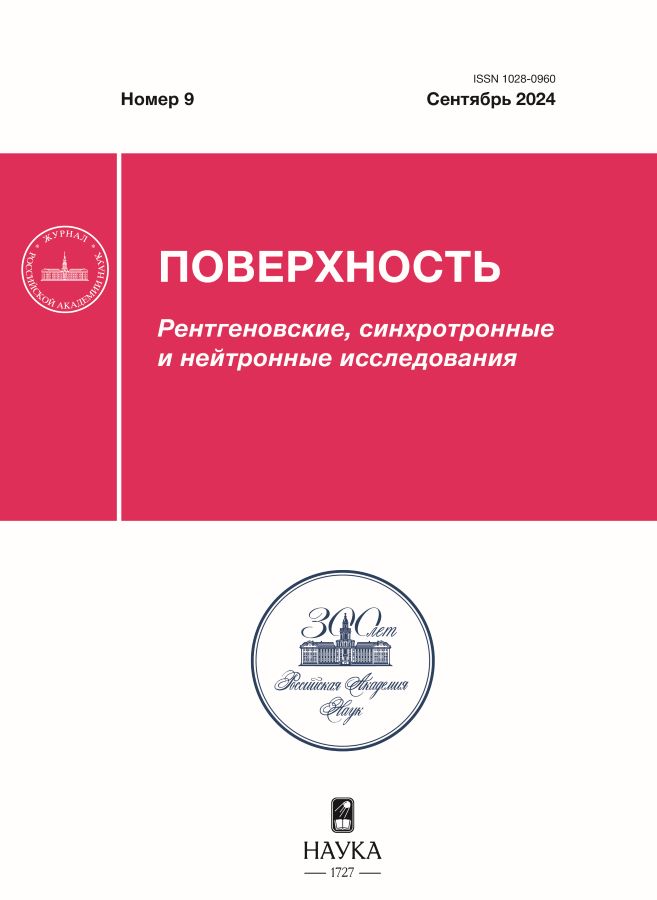Synthesis of gallium (II) sulfide
- Authors: Borisenko D.N.1
-
Affiliations:
- Osipyan Institute of Solid State Physics RAS
- Issue: No 9 (2024)
- Pages: 35-41
- Section: Articles
- URL: https://rjmseer.com/1028-0960/article/view/664745
- DOI: https://doi.org/10.31857/S1028096024090046
- EDN: https://elibrary.ru/EIJNVW
- ID: 664745
Cite item
Abstract
The synthesis of gallium (II) sulfide was carried out from elements in a closed volume using a two-temperature method. Passivation of the gallium surface in vacuum is observed up to temperature of 1623 К. The controlled chemical reaction was carried out in a hydrogen atmosphere at a pressure of 1300–2600 Pa. Similar results were achieved in vacuum using photocatalysis with ultraviolet radiation at a wavelength of 240–320 nm with a radiant power of 24.6 W. In both cases, at the temperature of 1323–1373 К, the gallium (II) sulfide synthesis time took no more than 30 minutes with a loading mass of 100 g. The Rietveld method was used to characterize crystalline gallium (II) sulfide by powder X-ray diffraction. The results of analysis showed that the product of the chemical reaction is single-phase GaS. The proposed solution to the problem of the gallium melt surface passivation for sulfur oligomers from the point of view of quantum electrodynamics made it possible to significantly reduce energy costs and increase the synthesis efficiency of extra pure gallium (II) sulfide for its further use in the chalcogenide glasses production.
Full Text
About the authors
D. N. Borisenko
Osipyan Institute of Solid State Physics RAS
Author for correspondence.
Email: bdn@issp.ac.ru
Russian Federation, Chernogolovka, 142432
References
- Гаджиева Н.Н., Мадатов Р.С., Асадов Ф.Г. // AJP Fizika. 2018. V. 25. № 3. P. 28.
- Naftaly M., Molloy J.F., Andreev Y.M., Kokh K.A., Lanskii G.V., Svetlichnyi1 V.A. // Opt. Exp. 2015. V. 23. Iss. 25. P. 32820. https://www.doi.org/10.1364/OE.23.032820
- Kokh K.A., Molloy J.F., Naftaly M., Andreev Yu.M., Svetlichnyi V.A., Lanskii G.V., Lapin I.N., Izaak T.I., Kokh A.E. // Mat. Chem. and Phys. 2015. V. 154. P. 152. https://www.doi.org/10.1016/j.matchemphys. 2015.01.058
- Molloy J.F., Naftaly M., Andreev Yu.M., Lanskii G.V., Lapin I.N., Potekaev A.I., Kokh K.A., Shabalina A.V., Shaidukobc A.V., Svetlichnyi V.A. // Cryst. Eng. Comm. 2014. V. 16. P. 1995. https://www.doi.org/10.1039/c3ce42230e
- Aydinli A., Gasanly N.M., Goksen K. // J. Appl. Phys. 2000. V. 88. № 12. P. 7144. https://www.doi.org/10.1063/1.1323515
- Kepinska M., Nowak M., Szalajko M. // J. Wide Bandgap Mater. 2001. V. 8. № 3–4. P. 241. https://www.doi.org/10.1106/152451102024667
- Zhong W., Liu Y., Yang X., Wang C., Xin W., Li Y., Liu W., Xu H. // Mater. Design. 2021. V. 212. P. 110233. https://www.doi.org/10.1016/j.matdes.2021.110233
- Gutiérrez Y., Juan D., Dicorato S., Santos G. Duwe, M., Thiesen P.H., Giangregorio M.M., Palumbo F., Hingerl K., Cobet C., García-Fernández P., Junquera J., Moreno F., Losurdo M. // Opt. Exp. 2022. V. 30. № 15. P. 27609. https://www.doi.org/10.1364/OE.459815
- Abderrahmane A., Senouci K., Hachemi B., Ko P.J. // Materials. 2023. V. 16. P. 4621. https://www.doi.org/10.3390/ma16134621
- Суханов М.В., Вельмужов А.П., Чурбанов М.Ф., Галаган Б.И., Денкер Б.И., Колташев В.В., Плотниченко В.Г., Сверчков С.Е. // Фотон-Экспресс. 2021. № 6. С. 86. https://www.doi.org/10.24412/2308-6920-2021-6-86-87
- Вельмужов А.П. Особо чистые стекла на основе халькогенидов германия и галлия для оптики среднего ИК диапазона. // Сборник тезисов Научной школы-конференции с международным участием для молодых ученых, Санкт-Петербург. 2022.
- Патент (РФ) 2770494. Способ получения особо чистых халькогенидных стекол, содержащих галлий. / ФГБУН ИХВВ им. Г.Г. Девятых РАН. Суханов М.В., Вельмужов А.П., Тюрина Е.А., Благин Р.Д. // 2022. Бюл. № 11.
- Гейдаров Б.А. // Известия Высших Учебных Заведений. Серия: Химия и химическая технология. 2008. Т. 51. Вып. 7. С. 14.
- Харнутова Е.П., Перов Э.И. // Успехи современного естествознания. 2011. № 9. С. 107.
- Патент (РФ) 2513930. Способ получения особо чистых сульфидов p-элементов III группы периодической системы. / ФГБУН ИХВВ им. Г.Г. Девятых РАН. Чурбанов М.Ф., Вельмужов А.П., Суханов М.В. // 2014. Бюл. № 11.
- Мамедов К.Н., Аббасов А.С., Рустамов П.Г., Мардахаев Б.Н. Теплофизические свойства твердых веществ. // Сборник материалов III Всесоюзной теплофизической конференции по свойствам веществ при высоких температурах. 1971.
- Шека И.А., Чаус И.С., Митюрева Т.Т. Галлий. Киев: Гос. изд-во технической литературы УССР, 1963. 296 с.
- Hahn H., Frank G. // Z. Anorg. Allg. Chem. 1955. Bd. 278. S. 340.
- Howard S.M. Ellingham Diagram for Selected Sulfides: Part 1. SD School of Mines and Technology, 2006. P. 26.
- Смирнов Б.М., Яценко А.С. // Успехи физических наук. 1996. Т. 166. № 3. С. 225.
- Химическая энциклопедия. Т. 1. М: Советская энциклопедия, 1988. 479 с.
- Карапетьянц М.Х., Карапетьянц М.Л. Основные термодинамические константы для неорганических и органических веществ. М.: Химия, 1968. 472 с.
- Глинка Н.Л. Общая химия. Л.: Химия, 1985. 702 с.
- Иванова Р.В. Химия и технология галлия. М.: Металлургия, 1973. 392 с.
- Верятин У.Д., Маширев В.П., Рябцев Н.Г., Тарасов В.И., Рогозкин Б.Д., Коробов И.В. Термодинамические свойства неорганических веществ. Справочник. 1965. 460 с.
- Жоров Ю.М. Термодинамика химических процессов. Нефтехимический синтез, переработка нефти, угля и природного газа. М.: Химия, 1985. 464 с.
- Ефимов А.И., Белорукова Л.П., Василькова И.В., Чечен В.П. Свойства неорганических соединений: Справочник. Л.: Химия, 1983. 392 с.
- Самсонов Г.В., Дроздова С.В. Сульфиды. М.: Металлургия, 1972. 304 c.
- PowderCell 2.0 for Windows (1998) Federal Institute for Materials Research and Testing, Berlin. http://mill2.chem.ucl.ac.uk/ccp/web-mirrors/powdcell/a_v/v_1/powder/details/powcell.htm
- PDF-2 Database (2024) International Centre for Diffraction Data. https://www.icdd.com/pdf-2/
- Стандарт ISO 21348:2007 Космическое пространство (естественное и искусственное). Определение энергетической освещенности солнечного излучения (2007) ФГБУ “Институт стандартизации”, Россия. https://www.gostinfo.ru/catalog/Details/?id3613943
- Вельмужов А.П., Суханов М.В., Чурбанов М.Ф., Котерева Т.В., Шабарова Л.В., Кириллов Ю.П. // Неорганические материалы. 2018. Т. 54. № 9. С. 977.
- Постников В.С. Оптическое материаловедение: курс лекций. Пермь: Изд-во Перм. нац. исслед. политехн. ун-та, 2013. 280 с.
Supplementary files














